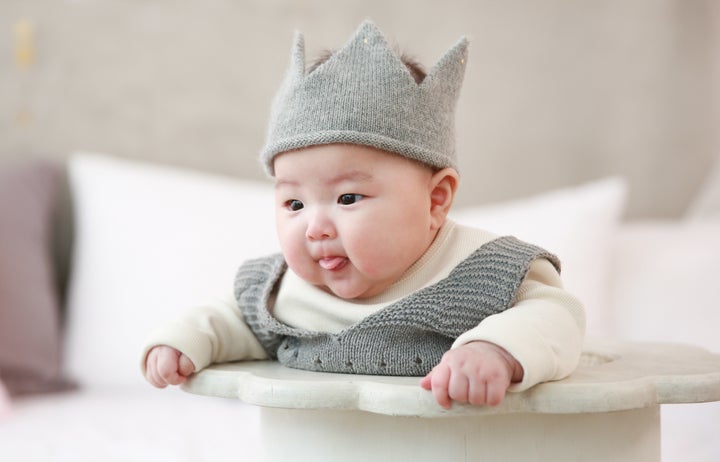
Royal baby names are always a hot topic of discussion, and with the due date of the Queen’s newest great-grandchild fast approaching, speculation is mounting around the names that may or may not have made Prince Harry and Meghan Markle’s list.
The bookies are backing Alice and Arthur, and the royal name watchers among us have been busy debating the merits of meaningful monikers like Diana, Dorothea, Spencer and Philip.
It’s true that British royal baby names tend to err on the classic side. Recent royal arrivals include the Duke and Duchess of Cambridge’s three children George, Charlotte and Louis, as well as some mainstream modern favorites like Mia and Isla.
But if you’re in the market for a truly unusual baby name with a ring of royal respectability, where better to look than to the realm of fiction and fantasy? Below is a selection of some of our favorite fantastical names belonging to princes and princesses of stage, page and screen.
Anatole
Prince Anatole Kuragin is a handsome rogue in Tolstoy’s War and Peace, whose courtship of Natasha Rostova causes her to end her engagement, and very nearly her life. But there are brighter associations, too: like Nobel Prize-winning author Anatole France. The name means “sunrise.”
Aravis
Aravis is the feisty heroine of C.S. Lewis’ The Horse and His Boy. Lewis may have been inspired by the atlas: the Chaîne des Aravis is a mountain range in eastern France.
Corin
From the same story comes Prince Corin, a fierce fighter and loyal friend. His name, quite fittingly, comes from the Latin Quirinus, meaning “spear.” Like fellow Narnian royal name Caspian, Corin strikes the sweet spot between soft, sensitive, and a little bit swashbuckling.
Cosimo
A tragic figure in Cornelia Funke’s Inkheart trilogy, Prince Cosimo is killed in battle against the series’ antagonists. An Italian variant of Cosmo (“order; decency”), the name has a real-life royal precedent in Cosimo de’ Medici, founding father of the dynasty that ruled Florence for much of the Renaissance.
Emerald
Both DC Comics and “Adventure Time” feature princesses by this name, plus variants like Emeralda (The Frog Princess) and Emeraude (Magic Knight Rayearth) abound. With its on-trend opening syllable and precious natural namesake, it’s no surprise that Emerald re-entered the U.S. Top 1000 in 2017.
Eilonwy
Pronounced “ay-LON-wee”, this literary invention belongs to a fiery-haired — and fiery-tempered — princess in Lloyd Alexander’s The Chronicles of Prydain. It may be based on a combination of literary Welsh eilon “deer” + the elaborating suffix -wy.
Ferdinand
Appearing in Shakespeare’s The Tempest, Ferdinand is a traditional royal name in many parts of Europe, including Spain, Portugal and Austria. Fittingly, considering its meaning of “bold voyager,” it’s also the first name of Portuguese explorer Magellan, who led the first circumnavigation of the Earth.
Florian
The Prince in Disney’s Snow White and the Seven Dwarfs sports one of the more wearable flowery royal boys’ names: there’s also Florimund (from the ballet The Sleeping Beauty) and Florizel (from Shakespeare’s The Winter’s Tale). Florian is particularly well used in Germany and Austria, where it currently ranks at No. 16.
Iseult
Also spelled Yseult or Isolde, this name appears in Arthurian legend as that of a beautiful Irish princess who falls in love with Tristan, one of the Knights of the Round Table.
Jonquil
Floral names for fictional princesses abound: from popular picks like Rose, Lily and Violet (Princess of the Midnight Ball), to the more daring Delphinium, Goldenrod and Hollyhock (Entwined). Jonquil feels like a nice middle ground: virtually unique, but not outlandish.
Lir
Prince Lír is the handsome and honorable hero of Peter S. Beagle’s The Last Unicorn. The name was apparently chosen because of its proximity to that of the Celtic sea god, Llyr (also a royal family name in The Chronicles of Prydain), and to Shakespeare’s King Lear.
Odette
The name of the good princess transformed into a swan in Tchaikovsky’s ballet Swan Lake, Odette (like her malevolent double Odile) derives from the Germanic name Odilia, meaning “wealth of the fatherland.”
Rollo
A jaunty name with a real royal precedent in the Viking chief who became the first Duke of Normandy, Rollo makes this list thanks to the young hero of Hans Christian Andersen’s The Princess and the Pea. It’s in rare but regular use in England, where it’s generally given to between five and10 babies per year.
Saphir
Add this one to the growing list of gemstone names for boys! With Jasper, Jet and Onyx all increasing in popularity, Saphir feels like a feasible option for bold baby namers. It belongs to a villainous prince in the anime series Sailor Moon.
Signy
A relatively popular choice in Norway throughout the first half of the 20th century, Signy has now all but fallen out of use in Scandinavia. But the name of the beautiful heroine of the Icelandic fairy tale Asmund and Signy still feels fresh to us, and it has a great meaning too: “new victory.”
Thaisa
A great many Shakespearean princesses could have rounded out this list: from innocent Miranda (The Tempest) to honest Cordelia (King Lear) to beautiful Perdita (The Winter’s Tale). But Thaisa (“ta-EE-sa,” the wife of Pericles) is one you might not have heard before. Variant forms Thaïs and Thaís are popular in France and Brazil, respectively.